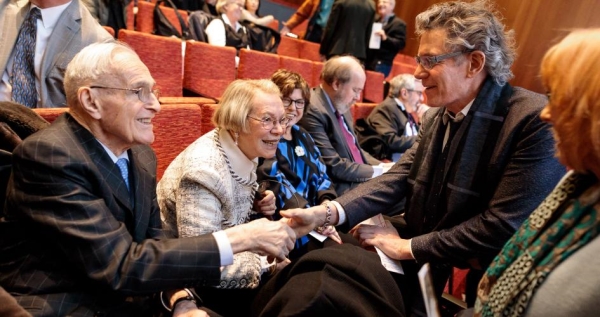
Acclaimed Chicago architect delivers first talk in 2018 Berlin Family Lectures
CHICAGO—(ENEWSPF)—April 17, 2018
By: Andrew Bauld
For architect Jeanne Gang, the materials that compose the built environment are as important to her as the final design.
Speaking April 10 at UChicago’s Logan Center for the Arts, Gang recalled visiting a ruin on St. John’s several years ago that served as inspiration: Although its craggy stone walls seemed unremarkable at first, Gang later discovered that they were made up of the skeletons of harvested coral and brick shards that were likely used as ballast on slave ships.
“The question is: Are all materials tainted with history, or can they be redeemed in some way?” Gang asked in her address, the first of three Randy L. & Melvin R. Berlin Family Lectures, in which the University highlights individuals making fundamental contributions to the arts, humanities and humanistic social sciences.
Gang is best known for combining elements of ecological systems into her designs—from the 82-story Aqua Tower (2010) in downtown Chicago, which resembles a landscape of hills and valleys; to the Ford Calumet Environmental Center (2008), which used the nest-making process of birds for inspiration.
“I’ve always been sensitive to materials in architecture, seeing the choice of them and the deployment of them on equal footing with the building’s function, its form, its technologies,” Gang added. “The issue of where materials come from, the resources they consume, where they end up, and the way they make people feel, are all central to my thoughts about architecture.”
In three talks entitled “Mining the City,” Gang will explore various elements of the built environment. She framed the first discussion around the ubiquitous three Rs of environmentalism—reduce, reuse, recycle—as starting points for “reusing physical resources rather than starting from complete scratch.”
In a wide-ranging discussion, Gang explored architecture and design from the growth of mass consumerism by the American public in the post-war 1950s, up to modern innovations for making better use of space through concepts like tiny houses and micro apartments.
Gang shared concepts for current and past projects, including the conversion of a former coal-burning power plant into a modern student union at Beloit College, to a network of flexible live-and-work units in the former factory town of suburban Cicero.
Pioneering architectural vision
Gang was introduced to a crowd April 10 by Christine Mehring, chair of the Department of Art History at UChicago, who recognized Gang as one of a handful of successful female architects in the history of architecture. Mehring praised Gang’s efforts to bring more diverse perspectives to the profession during a celebrated career.
“In little over a decade, Jeanne has built an international reputation for advancing and intertwining the social, elemental and formal possibilities of architecture and design in the 21st century,” Mehring said.

John Zich
The founding principal of Studio Gang, an international architecture and urban design practice based in Chicago, New York and San Francisco, Gang was awarded a MacArthur Fellowship in 2011, which recognized her as “an architect challenging the aesthetic and technical possibilities of the art form in a wide range of structures.” Locally, her projects include the Nature Boardwalk at Lincoln Park Zoo (2010), Northerly Island (2015) and closer to UChicago, the Campus North Residential Commons (2016).
Most recently, Gang also was named one of seven designers selected by the curatorial team for the U.S. Pavilion at the 2018 Venice Architecture Biennale, for which the University of Chicago and the School of the Art Institute of Chicago are serving as commissioners.
Gang’s next Berlin Lecture is April 17, a talk entitled “The Uneven City,” which will followed by her final talk on April 24, “Mutualism in the Anthropocene.” Both will begin at 6 p.m. in the Performance Hall at the Logan Center.
Source: www.uchicago.edu








